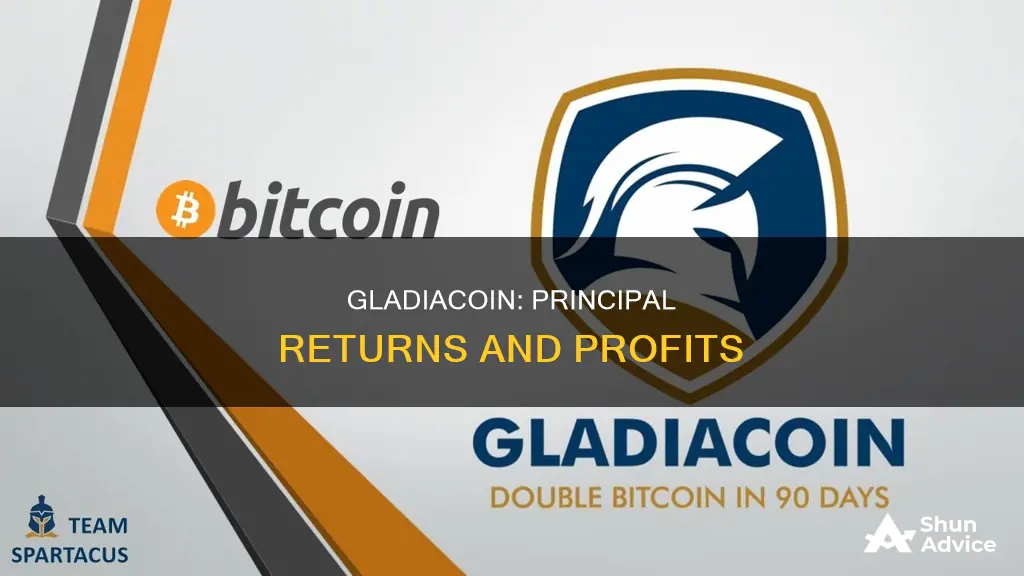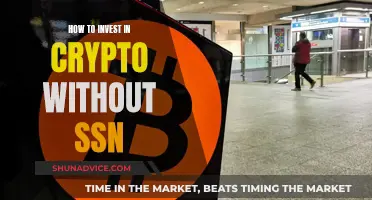
Gladiacoin was a company founded on November 26, 2016, that promised to double bitcoin investments in 90 days. The company was based on a Ponzi scheme model, relying on funds from new investors to pay returns to existing investors. In June 2017, Gladiacoin collapsed, leaving many investors with significant losses. While some individuals reported receiving multiple payouts on their investments, others lost substantial amounts of money, in some cases, over 4 Bitcoin. The anonymous scammers behind Gladiacoin have since spawned a number of clones, and it is unlikely that those who lost money will be able to recover their principal investment.
| Characteristics | Values |
|---|---|
| Company Model | Ponzi Scheme |
| Promise | Double your bitcoin in 90 days |
| Earnings | 2.2% payout dividend |
| Collapse | June 2017 |
| Founders | Satur Segade, Oscar Gonzalez-Batista, Antonio Casas, and William Portillo |
What You'll Learn

Gladiacoin's business model
Gladiacoin was a company founded on November 26, 2016, which promised to double bitcoin investments in 90 days. The company was based on a Ponzi scheme model, where new investors' funds were used to pay existing investors. Gladiacoin also had a pyramid recruiting component, where investors could double their bitcoin even faster if they signed up other people on the binary network to receive a bonus.
The company offered a 200% ROI in 90 days, with a 2.2% payout dividend and a fully automated system. However, Gladiacoin collapsed in June 2017, and many investors lost money.
The business model of Gladiacoin was unsustainable and relied on continually attracting new investors to pay existing ones. This is a classic Ponzi scheme structure, and ultimately led to the company's demise. The collapse of Gladiacoin also spawned a number of clones, such as JetCoin, Royal Dragon Traders, and Cointherum, which operated using the same business model.
The end result of such schemes is that the majority of affiliates lose money to the big recruiter minority. The anonymous scammers running these schemes make off with the money, and investors are left with little recourse to recover their losses.
Litecoin's Long-Term Investment Prospects: Worth the Risk?
You may want to see also

Gladiacoin's collapse
Gladiacoin was a company founded on 26 November 2016, which promised to double bitcoin investments in 90 days. The company was based on a Ponzi scheme model, where new investors' funds were used to pay existing investors.
In late May 2017, GladiaCoin started facing issues and suspended affiliate ROI payouts for five days, blaming “conditions of the blockchain network”. Withdrawal restrictions were also tightened, and the minimum withdrawal amount was increased.
In an attempt to recapture ROI payouts, GladiaCoin introduced higher investment amounts and a 15% monthly fee on the initial investment amount. However, the company continued to deteriorate and, on June 3, 2017, suspended ROI payouts for another week.
In an email sent out to affiliates on June 10, 2017, the company admitted that it would not meet its advertised 200% ROI on any funds invested that had already paid back more than the initial investment. The company's recent issues with ROI payouts were not due to cryptocurrency trading but rather due to a lack of new investments.
The collapse of Gladiacoin, also known as the "Double your money in 90 days company", took place during June 2017, leaving many investors with significant losses. The company's website is no longer active, and it is highly unlikely that those who lost money will be able to recover their investments.
A Guide to Investing in Litecoin: India Edition
You may want to see also

The nature of Gladiacoin as a Ponzi scheme
Gladiacoin was a company founded on November 26, 2016, which promised to double bitcoin in the period of 90 days. The earnings included a 2.2% payout dividend with a fully automated system. Gladiacoin was a company based upon a “Ponzi-scheme” model.
The basic premise of a Ponzi scheme is "to rob Peter to pay Paul". Initially, the operator pays high returns to attract investors and entice current investors to invest more money. When other investors begin to participate, a cascade effect begins. The schemer pays a "return" to initial investors from the investments of new participants, rather than from genuine profits.
In the case of Gladiacoin, affiliates were able to invest bitcoin on the promise of an advertised 90-day 200% ROI. Affiliates were paid a percentage of matched investment volume, that being all volume from the weaker binary side. The more an affiliate invested, the higher their income potential via the Gladiacoin compensation plan.
The ruse behind Gladiacoin’s 200% ROIs was “bitcoin trading operations”. Gladiacoin claimed to purchase bitcoin from one exchange and sell it on another. However, as is typical of cryptocurrency Ponzi schemes, no specific details were provided.
In reality, Gladiacoin was simply using newly invested funds to pay off existing investors, sans whatever they paid out in binary (recruitment) commissions. Once the initially invested funds were exhausted, it was unlikely that Gladiacoin would survive a second round of ROI payouts. With the exception of those who joined back in December 2016, the majority of Gladiacoin affiliates were otherwise destined to lose money.
In June 2017, Gladiacoin collapsed and the website, gladiacoin.com, was taken down.
The Ultimate Guide to Investing in Dogecoin
You may want to see also

Other cryptocurrency doublers
Gladiacoin was a company founded on November 26, 2016, that promised to double bitcoin in 90 days. The company operated on a Ponzi scheme model and collapsed in June 2017.
While it is not possible to get your principal investment back with Gladiacoin, there are other cryptocurrency doublers in the market. However, it is important to exercise caution as many of these doublers may also be scams. Here are some alternative cryptocurrency doublers:
- Coin Doubler: This is an investment platform that allows users to earn interest on their cryptocurrencies without any human intervention. Coin Doubler's automated system gathers information from blockchain transfers and cryptocurrency exchanges to study and predict cryptocurrency prices. It opens and closes thousands of transactions per minute, analyzing price differences and transaction fees to generate profit. The minimum deposit is 0.01 BTC, and the platform offers full transparency by allowing users to monitor all deposits and payouts in real time.
- Bitcoin Doubler: Bitcoin Doubler is another fully automated investment platform that promises to double your BTC in just 10 hours. Similar to Coin Doubler, it gathers information from blockchain transfers and cryptocurrency exchanges to predict Bitcoin prices. It also offers a user-friendly interface, a dynamic table to track investments, and a secure website with SSL protection. The minimum investment is 0.005 BTC, and the maximum is 10 BTC.
It is important to remember that investing in cryptocurrency doublers comes with risks. Always do your own research, and only invest what you can afford to lose.
Dogecoin: Long-Term Investment or Just a Meme?
You may want to see also

The risks of investing in Gladiacoin
Gladiacoin was a company founded on November 26, 2016, which promised to double bitcoin investments in 90 days. The company was based on a Ponzi scheme model, and it collapsed in June 2017.
Lack of Transparency
Gladiacoin did not provide full transparency into how they generated returns. The company claimed to have a fully automated system, but there was no proof of any trading activity.
High-Risk, Unregulated Investment
Investing in Gladiacoin was always going to be a high-risk proposition. The company promised extremely high returns (200% ROI in 90 days) with little to no risk, which is a significant red flag in any investment opportunity. Additionally, cryptocurrency investments are largely unregulated, making it easier for scammers to operate.
Ponzi Scheme Structure
The business model of Gladiacoin was dependent on new investors signing up and putting money into the system. This is a classic characteristic of a Ponzi scheme, where new investor money is used to pay existing investors. This is not a sustainable business model and is destined to collapse, leaving many investors with losses.
Anonymous Scammers
The people behind Gladiacoin were anonymous, making it difficult to hold them accountable. The true identities of the scammers were hidden, and they were based in South America, further complicating any legal recourse for investors.
Withdrawal Issues and Changing Terms
Gladiacoin had issues with processing withdrawals and frequently changed the terms of their investment offerings. They suspended affiliate ROI payouts, tightened withdrawal restrictions, and introduced higher investment amounts and additional fees. These are tactics commonly used by scammers to buy time and extract more money from investors before ultimately collapsing.
Loss of Principal Investment
When Gladiacoin collapsed, many investors lost their principal investments. There was no guarantee of getting the initial investment back, and the company's anonymous owners disappeared with the funds.
In conclusion, investing in Gladiacoin carried significant risks due to its Ponzi scheme structure, anonymous ownership, lack of transparency, and frequent changes in withdrawal policies and fees. The high-risk nature of cryptocurrency investments and the lack of regulation in this space further exacerbated these risks. Ultimately, many investors lost their money when the company collapsed.
Cryptocurrency Investment: Safe or Risky Business?
You may want to see also
Frequently asked questions
Gladiacoin was a company founded on November 26, 2016, which promised to double bitcoin in a period of 90 days. Gladiacoin was a company based upon a Ponzi scheme model.
Yes, the collapse of Gladiacoin took place during the month of June 2017.
Unfortunately, it seems unlikely that you will be able to recover your initial investment. One source states that Gladiacoin was a clean collapse, and that it is far too late to do anything about your losses. Chalk it up as an expensive lesson in fraud.
In the future, be wary of any company that promises to double your money in a short period of time, as this is usually a sign of a Ponzi scheme. Do your own research and be cautious before investing in any company, especially if they are making unrealistic promises.







